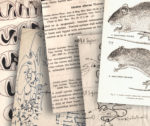Revisión de libros
David FloresRevisión de Opossums: an adaptive radiation of New World marsupials. Robert S. Voss & Sharon Jansa. Johns Hopkins University Press, 2021.

Revista Científica SAREM–SBMz
Revisión de Opossums: an adaptive radiation of New World marsupials. Robert S. Voss & Sharon Jansa. Johns Hopkins University Press, 2021.


Anormalidades reproductivas en organismos silvestres se describen con poca frecuencia. En esta nota reportamos la presencia de fetos extrauterinos, un caso de cuerno uterino supernumerario y litopediones, en tres especies comunes de roedores sigmodontinos del norte del departamento boliviano de La Paz: Akodon dayi, Euryoryzomys nitidus y Oligoryzomys microtis. Lo encontrado se puede deber a un debilitamiento en las paredes de los cuernos uterinos. Es destacable que tres de los cuatro casos detectados provengan de zonas de cultivo, situación que podría sugerir una vinculación causal con agroquímicos.
Reproductive abnormalities in wild female sigmodontine rodents from northern La Paz, Bolivia. Reproductive abnormalities in wild organisms are rarely reported. In this note we describe the presence of abdominal pregnancies, supernumerary uterine horn, and lithopedions in three common species of sigmodontine rodents of the northern La Paz department (Bolivia): Akodon dayi, Euryoryzomys nitidus, and Oligoryzomys microtis. These may be due to a weakening in the walls of the uterine horns. It is noteworthy that four of the five cases found come from agricultural areas, which could suggest a causal link with agrochemicals.

Zooarchaelogical research brings together anthropology and biology providing insights into human-animal associations through time. Here we report on two unusual zooarchaeological findings of mammals in colonial churches of Ecuador: 1) an opossum, Didelphis pernigra (Didelphidae, Didelphimorphia), found in an arrangement typical of a north Andean pre-Columbian human burial, with the body inside a clay pot and with food—a corn cob in this case. The opossum was most likely buried during the first reconstruction of the monastery del Carmen Alto, Quito, in the 17th century, around the year 1656 AD; and, 2) an introduced black rat, Rattus rattus (Rodentia, Muridae), found inside a 19th century human tomb; both bodies, human and rodent, were naturally mummified. The rat was found in the monastery de la Asunción, Guano. These findings help to understand human-mammal associations as an indigenous ritual taking place in a catholic temple, and to date the invasion of R. rattus in a small town in the Ecuadorian Andes.
Hallazgos zooarqueológicos inusuales de Didelphis pernigra y Rattus rattus en dos monasterios coloniales del Ecuador. La investigación zooarqueológica une a la antropología y a la biología brindando luces sobre la asociación humano-animal a través del tiempo. Aquí reportamos dos hallazgos zooarqueológicos inusuales de mamíferos en iglesias coloniales del Ecuador: 1) una zarigüeya, Didelphis pernigra (Didelphidae, Didelphimorphia), hallada en un arreglo típico de un entierro funerario humano pre-colombino de los Andes del Norte, con el cuerpo dentro de una vasija de barro y con comida —una mazorca de maíz en este caso—. La zarigüeya muy probablemente fue colocada en este arreglo durante la primera reconstrucción del monasterio del Carmen Alto en Quito, en el siglo XVII, alrededor del año 1656 dC; y 2) una rata negra introducida, Rattus rattus (Rodentia, Muridae), encontrada dentro de una tumba humana del siglo XIX; ambos cuerpos, humano y roedor, se momificaron naturalmente. La rata fue encontrada en el monasterio de la Asunción, Guano. Estos hallazgos ayudan a comprender asociaciones humano-animal como un ritual indígena que tuvo lugar en un templo católico y a datar la invasión de R. rattus en un pueblo pequeño de los Andes ecuatorianos.

Se describe una nueva especie de Philander (Marsupialia, Didelphimorphia, Didelphidae) procedente de niveles de la Formación Andalhuala (Mioceno tardío) de la localidad de Tio Punco, provincia de Tucumán (Argentina). Comparada con las especies vivientes del género, la nueva especie es de tamaño relativamente grande y sus premolares y molares son de aspecto robusto; el cráneo tiene las crestas frontales cortas y más transversales al eje craneano; la diastema entre los P1-2 es corta; el cíngulo labial del P3 es incompleto y vestigial; los molares superiores tienen los protoconos más robustos y la postmetacrista del M3 está menos desarrollada.
A new species of Philander (Marsupialia, Didelphidae) from the late Miocene of northwestern Argentina. A new species of Philander (Marsupialia, Didelphimorphia, Didelphidae), from levels of the Andalhuala Formation (late Miocene) at Tio Punco locality, Tucumán province (Argentina) is described. Compared to the living species of the genus, the new species is relatively large and has stronger premolars and molars; the skull has short frontal crests which are more transversally placed regarding the cranial axis; the diastema between P1 and P2 is short; the labial cingulum of P3 is vestigial and incomplete; upper molars have more robust protocones, and the posmetacrista of M3 is less developed.

La presencia del yaguarundí, Herpailurus yagouaroundi (É. Geoffroy Saint-Hilaire, 1803) en Uruguay ha sido controversial. Sistematizamos sus registros y analizamos menciones históricas y recientes. Existen varios reportes en los siglos XIX y XX, aunque sin evidencia material. Eso llevó a excluirlo de la mastofauna uruguaya entre 1972 y 2016, año este último en que fue documentado mediante cámaras trampa. La información nacional y regional sugiere que, en la actualidad y probablemente en el pasado, se han registrado en Uruguay dos morfos de pelaje (oscuro y rojizo). Sería una especie escasa y posiblemente amenazada y se necesitan más estudios para determinar su estado de conservación en el país.
The jaguarondi, Herpailurus yagouaroundi (Carnivora: Felidae) in Uruguay: historical account and current situation. The presence of the jaguarondi, Herpailurus yagouaroundi (É. Geoffroy Saint-Hilaire, 1803) in Uruguay has been controversial.We systematized its records and analyzed historical and current mentions. There have been reports in the 19th and 20th centuries, although without material evidence. This led to the species not being considered among the native fauna between 1972 and 2016 when it was finally documented with camera traps. The information at national and regional levels suggests that currently and probably in the recent past, two pelage variants (grey and reddish) were recorded in Uruguay. Albeit it is scarce and possibly endangered in Uruguay, more studies are needed to assess the conservation status in the country.

We report the southernmost locality for the sigmodontine rodent Deltamys kempi Thomas, 1917, in Arroyo Las Tijeras (36° 22′ 43″ S, 56° 50′ 12″ W, General Lavalle county) near the coast of Buenos Aires province (Argentina), extending the range of the species ca. 150 km S. This record is a wake-up call about the presence of Brazilian fauna well beyond their southernmost suspected limit. Several lines of evidence point to considering D. kempi as a very recent immigrant in Argentina.
Registro más austral de Deltamys kempi (Rodentia, Cricetidae) en Argentina: evidencia paleontológica y neontológica para evaluar su distribución. Reportamos la localidad más austral para el roedor sigmodontino Deltamys kempi Thomas, 1917: Arroyo Las Tijeras (36° 22′ 43″ S, 56° 50′ 12″ O, Partido de General Lavalle), cerca de la costa de la Provincia de Buenos Aires (Argentina), extendiendo el rango geográfico de la especie ca. 150 km hacia el sur. Este registro constituye una llamada de alerta acerca de la presencia de fauna brasílica bastante más al sur que lo sospechado. Varias líneas de evidencia indican que D. kempi puede ser un inmigrante muy reciente en la fauna argentina.

In the Bolivian Gran Chaco, woody plant encroachment (WPE) is gradually replacing open habitats such as grassland and savannah. This change in vertical structuring of native open vegetation may create hunting cover for predators. Therefore, animal species naturally dependent on open habitats, enabling effective visual scanning of their environment, may need to adapt to a denser vegetation structure to survive. Hence, we expected a negative consequence of increasing WPE intensity in the grasslands of the Bolivian Gran Chaco, on the population of guanacos (Lama guanicoe) at the species’ northerly distribution limit. We analysed guanaco alert responses under different conditions, whether the animals: 1) modified their response according to habitat structure; 2) varied their escape response according to their group size and composition; and 3) responded differently to observers (these approaching either on foot or horseback). The habitat variable (open versus dense) was the strongest predictor of an alert response, irrespective of whether guanacos were alone or in groups. Contrary to our expectation, guanacos were more alert when in open habitat. In addition, we found no evidence for the effect of habitat type on group size. Finally, there was a significant association between observation method and guanaco alert response. We suggest that the current combination of relatively high densities of predators such as puma (Puma concolor), and jaguar (Panthera onca) together with WPE-driven replacement of natural, open habitat preferred by Chacoan guanacos, could diminish the potential recovery and survival of this population of guanacos, currently threatened in Bolivia.
La respuesta de alerta de los guanacos en el Gran Chaco boliviano se ve afectada por un entorno cambiante impulsado por la invasión de plantas leñosas. En el Gran Chaco Boliviano, la invasión de plantas leñosas (WPE) está reemplazando gradualmente hábitats abiertos como pastizales y sabanas. Este cambio en la estructura vertical de la vegetación abierta nativa puede crear una cobertura de caza para los depredadores. Por lo tanto, las especies animales que dependen naturalmente de hábitats abiertos, lo que permite un escaneo visual efectivo de su entorno, pueden necesitar adaptarse a una estructura de vegetación más densa para sobrevivir. Por lo mencionado anteriormente, esperábamos una consecuencia negativa del aumento de la intensidad del WPE en los pastizales del Gran Chaco boliviano, sobre la población de guanacos (Lama guanicoe) en el límite de distribución norte de la especie. Analizamos las respuestas de alerta del guanaco bajo diferentes condiciones, ya sea que los animales: 1) modificaran su respuesta de acuerdo con la estructura del hábitat; 2) variaran su respuesta de escape de acuerdo con el tamaño y la composición de su grupo; y 3) respondieran de manera diferente a los observadores (que se acercaban a pie o a caballo). La variable de hábitat (abierto versus denso) fue el predictor más fuerte de una respuesta de alerta, independientemente de si los guanacos estaban solos o en grupos. Contrariamente a nuestras expectativas, los guanacos estaban más alerta cuando estaban en hábitat abierto. Además, no encontramos evidencia del efecto del tipo de hábitat en el tamaño del grupo. Finalmente, hubo una asociación significativa entre el método de observación y la respuesta de alerta del guanaco. Sugerimos que la combinación actual de densidades relativamente altas de depredadores como el puma (Puma concolor) y el jaguar (Panthera onca), junto con el reemplazo impulsado por el WPE del hábitat natural abierto preferido por los guanacos del Chaco, podría disminuir la recuperación potencial y la supervivencia de esta población de guanacos, actualmente amenazada en Bolivia.

En esta investigación usamos códigos de barras de ADN como una herramienta para el análisis de la diversidad específica y la variabilidad geográfica de roedores Sigmodontinae (Cricetidae) en el norte de Argentina. Analizamos 162 individuos de 50 localidades pertenecientes a 31 especies originalmente determinadas mediante morfología. El 72% de las localidades estudiadas se encuentran en las Yungas mientras que el 71% de las especies analizadas habita en alguno de sus estratos altitudinales. Se realizaron dos análisis de delimitación de especies: la implementación bayesiana del método «Poisson Tree Processes» (bPTP) y el método «Automated Barcode Gap Discovery» (ABGD), este último bajo dos modelos de sustitución, K2P y JC69. El método bPTP evidenció linajes diferentes en algunas especies totalizando un recuento de 44 especies, 13 más que las 31 originalmente detectadas. El método ABGD resultó en 40 especies en promedio para todas las particiones recursivas de los dos modelos de sustitución utilizados. Las especies que presentaron más de un linaje genético (especies putativas) con respecto a su determinación original fueron las siguientes: Akodon budini, Akodon simulator, Akodon spegazzinii, Andinomys edax, Necromys lactens, Oligoryzomys chacoensis, Oligoryzomys flavescens y Phyllotis tucumanus. Los resultados obtenidos sugieren una diversidad de roedores sigmodontinos más elevada que la actualmente reconocida en la región de estudio y destacan la necesidad de relevamientos faunísticos más exhaustivos que permitan un apropiado inventario de la biodiversidad.
Using DNA Barcoding for delimitation of species in sigmodontine rodents (Cricetidae) in north Argentina with special emphasis on those of the Yungas forest. We used DNA barcodes to explore the species diversity and the geographic variability of Sigmodontinae (Cricetidae) rodents in North Argentina. We analyzed 162 individuals from 50 localities belonging to 31 species primarily determined by morphology. Most of the studied localities (72%) are from the Yungas forest while 71% of the analyzed species inhabit some of their altitudinal strata. We performed two species delimitation analyses, the Bayesian Poisson Tree Processes (bPTP) method, and the Automated Barcode Gap Discovery (ABGD) method, the latter under two substitution models K2P and JC69. The bPTP method reported the presence of different lineages in some species totaling 44 species, 13 more than the 31 originally listed in our database. The ABGD method resulted in 40 species on average for all recursive partitions under the two substitution models. The following species presented more than one genetic lineage (putative species): Akodon budini, Akodon simulator, Akodon spegazzinii, Andinomys edax, Necromys lactens, Oligoryzomys chacoensis, Oligoryzomys flavescens and Phyllotis tucumanus. Our results suggest that the diversity of sigmodontine rodents in northwestern Argentina is higher than the currently recognized, and highlight the need for more exhaustive faunal surveys which allow a more accurate biodiversity inventory.

The white-eared opossum Didelphis albiventris Lund, 1840, is one the largest and most common species of marsupial in Argentina, distributed from the north of the country up to Neuquén and Río Negro provinces in the south. The species is present in contrasting environments, such as the Monte (desert) and the Parana Forest (rainforest), and is also adapted to live in large cities and agricultural fields. Although there are some phylogeographic analyses of Brazilian populations of D. albiventris, showing little variation and some geographic structure, up to now none of them included samples from Argentina. The aim of this contribution is to analyze the genetic structure of the species, using two mitochondrial markers (cytochrome b and D-loop) on a wide geographic coverage in Argentina (> 10° S). Results showed little genetic variation and low haplotype diversity, with lesser values than those reported for Brazilian populations. This small variation could be due to a sudden expansion, which is supported by field observations of the species expanding to the south. Unfortunately, the low genetic variability resulted in low statistical power to give conclusive results in the mismatch analysis or the Bayesian skyline plot. Another possibility is high levels of gene flow, which is consistent with the low correlation beween genetic and geographic distances detected in the Mantel test (althogh statistically significant) and the wide home range that the species has. A different approach, using a different set of markers, is needed in order to analyze the phylogeographic history of D. albiventris.
Diversidad genética de la comadreja overa Didelphis albiventris (Didelphimorphia: Didelphidae) en Argentina. La comadreja overa Didelphis albiventris Lund, 1840, es una de las especies de marsupiales más grandes y comunes en Argentina y se distribuye desde el norte del país hasta las provincias de Neuquén y Río Negro en el sur. La especie está presente en ambientes dispares, como el Monte (desierto) y la Selva Paranaense (bosque lluvioso) y también está adaptada a vivir en grandes ciudades y regiones agrícolas. Aunque existen algunos análisis filogeográficos de poblaciones brasileñas de D. albiventris que muestran poca variación y cierta estructura geográfica, hasta el momento ninguno de ellos incluyó muestras provenientes de Argentina. El objetivo de esta contribución es analizar la estructura genética de la especie utilizando dos marcadores mitocondriales (citocromo b y D-loop) y una amplia muestra geográfica proveniente de Argentina (> 10° S). Los resultados mostraron poca variación genética y baja diversidad de haplotipos, con valores inferiores a los descriptos para las poblaciones brasileñas. Esta escasa variabilidad podría deberse a una expansión reciente, hipótesis respaldada por observaciones de campo de la especie expandiéndose hacia el sur. Sin embargo, la baja variabilidad encontrada resultó en una falta de poder estadístico para dar resultados concluyentes en el análisis de Mismatch o en el Bayesian skyline plot. Otra posibilidad serían altos niveles de flujo génico, algo consistente con la baja correlación (aunque estadísticamente significativa) entre distancias genéticas y geográficas en la prueba de Mantel y el amplio rango de acción que tiene la especie. Se necesita un enfoque diferente, utilizando otros marcadores más variables, para analizar la historia filogeográfica de D. albiventris.
